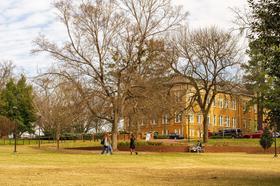Serving 763 students in grades Prekindergarten-5, St. Cloud Elementary School ranks in the top 50% of all schools in Florida for overall test scores (math proficiency is bottom 50%, and reading proficiency is bottom 50%).
The percentage of students achieving proficiency in math is 49% (which is lower than the Florida state average of 52%). The percentage of students achieving proficiency in reading/language arts is 58% (which is higher than the Florida state average of 52%).
The student-teacher ratio of 16:1 is lower than the Florida state level of 17:1.
Minority enrollment is 60% of the student body (majority Hispanic), which is lower than the Florida state average of 65% (majority Hispanic).
Quick Facts (2026)
- Grades: Prekindergarten-5
- Enrollment: 763 students
- Student-Teacher Ratio: 16:1
- Minority Enrollment: 60%
- Overall Testing Rank: Top 50% in FL
- Math Proficiency: 49% (Btm 50%)
- Reading Proficiency: 58% (Top 50%)
- Science Proficiency: 40-44% (Btm 50%)
- Source: National Center for Education Statistics (NCES), FL Dept. of Education
School Overview
St. Cloud Elementary School's student population of 763 students has declined by 11% over five school years.
The teacher population of 49 teachers has declined by 16% over five school years.
Grades Offered
Grades Prekindergarten-5
(No virtual instruction)
(No virtual instruction)
Total Students
763 students
Gender %
Total Classroom Teachers
49 teachers
Year Founded
1905
Last Day of School
Mon. May 25, 2026
School Rankings
St. Cloud Elementary School ranks within the top 50% of all 3,662 schools in Florida (based off of combined math and reading proficiency testing data).
The diversity score of St. Cloud Elementary School is 0.61, which is less than the diversity score at state average of 0.70. The school's diversity has stayed relatively flat over five school years.
Overall Testing Rank
#1569 out of 3662 schools
(Top 50%)
(Top 50%)
Math Test Scores (% Proficient)
49%
52%
Reading/Language Arts Test Scores (% Proficient)
58%
52%
Science Test Scores (% Proficient)
40-44%
52%
Student-Teacher Ratio
16:1
17:1
American Indian
n/a
n/a
Asian
2%
3%
Hispanic
48%
37%
Black
5%
21%
White
40%
35%
Hawaiian
n/a
n/a
Two or more races
5%
4%
All Ethnic Groups
Participates in the National School Lunch Program (NSLP)
Yes
Eligible for Free Lunch
52%
47%
Eligible for Reduced Lunch
9%
4%
School Statewide Testing
School District Name
Source: National Center for Education Statistics (NCES), FL Dept. of Education
Profile last updated: 02/09/2025
Frequently Asked Questions
What is St. Cloud Elementary School's ranking?
St. Cloud Elementary School is ranked #1569 out of 3,662 schools, which ranks it among the top 50% of public schools in Florida.
What schools are St. Cloud Elementary School often compared to?
St. Cloud Elementary Schoolis often viewed alongside schools like Narcoossee Elementary School, Hickory Tree Elementary School by visitors of our site.
What percent of students have achieved state testing proficiency in math and reading?
49% of students have achieved math proficiency (compared to the 52% FL state average), while 58% of students have achieved reading proficiency (compared to the 52% FL state average).
How many students attend St. Cloud Elementary School?
763 students attend St. Cloud Elementary School.
What is the racial composition of the student body?
48% of St. Cloud Elementary School students are Hispanic, 40% of students are White, 5% of students are Black, 5% of students are Two or more races, and 2% of students are Asian.
What is the student-teacher ratio of St. Cloud Elementary School?
St. Cloud Elementary School has a student ration of 16:1, which is lower than the Florida state average of 17:1.
What grades does St. Cloud Elementary School offer ?
St. Cloud Elementary School offers enrollment in grades Prekindergarten-5 (No virtual instruction).
What school district is St. Cloud Elementary School part of?
St. Cloud Elementary School is part of Osceola School District.
School Reviews
Review St. Cloud Elementary School. Reviews should be a few sentences in length. Please include any comments on:
- Quality of academic programs, teachers, and facilities
- Availability of music, art, sports and other extracurricular activities
Recent Articles

Public School Transportation & Commute Planning Guide
Learn how public school transportation and commute planning can help families prepare for the coming school year safely and efficiently.

New Public School Safety Protocols 2025–26 Guide
Learn how new public school safety protocols for 2025–26 affect students, parents, and schools nationwide.

How Technology Transforms Education in 2025
Explore how technology shapes learning today, with updated data, policy context, trends, and real-world implications for students, educators, and families.





